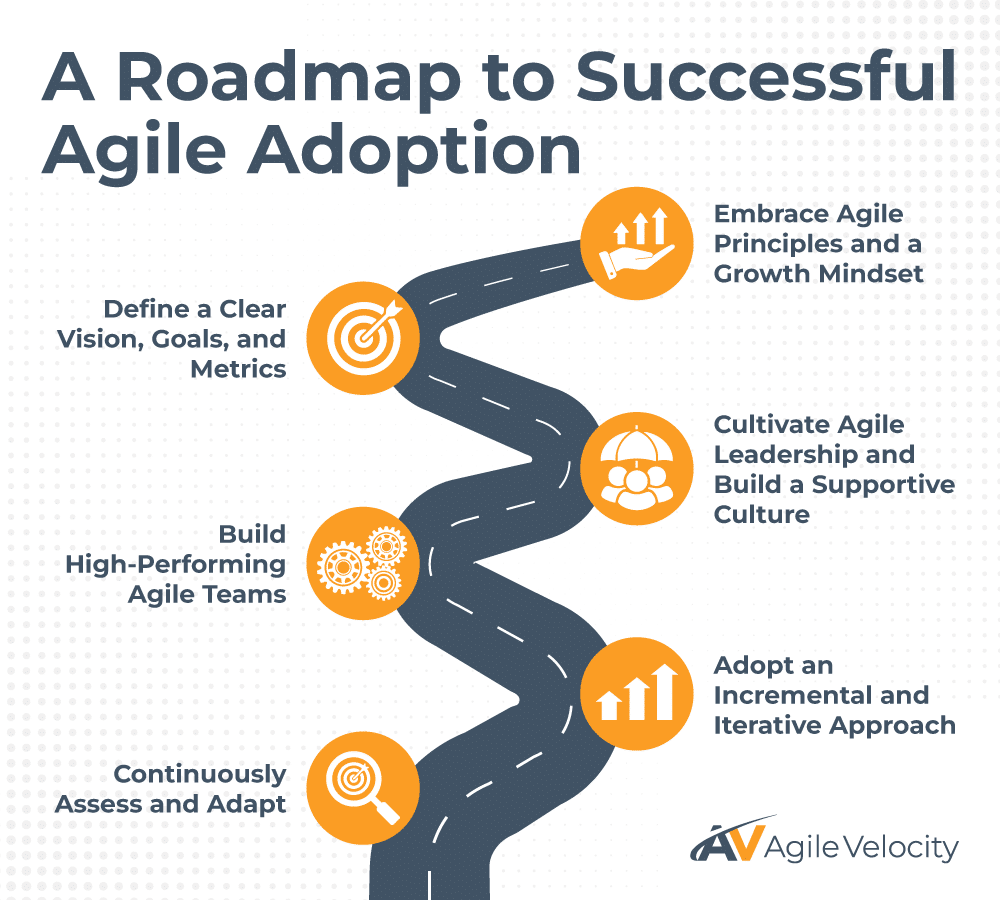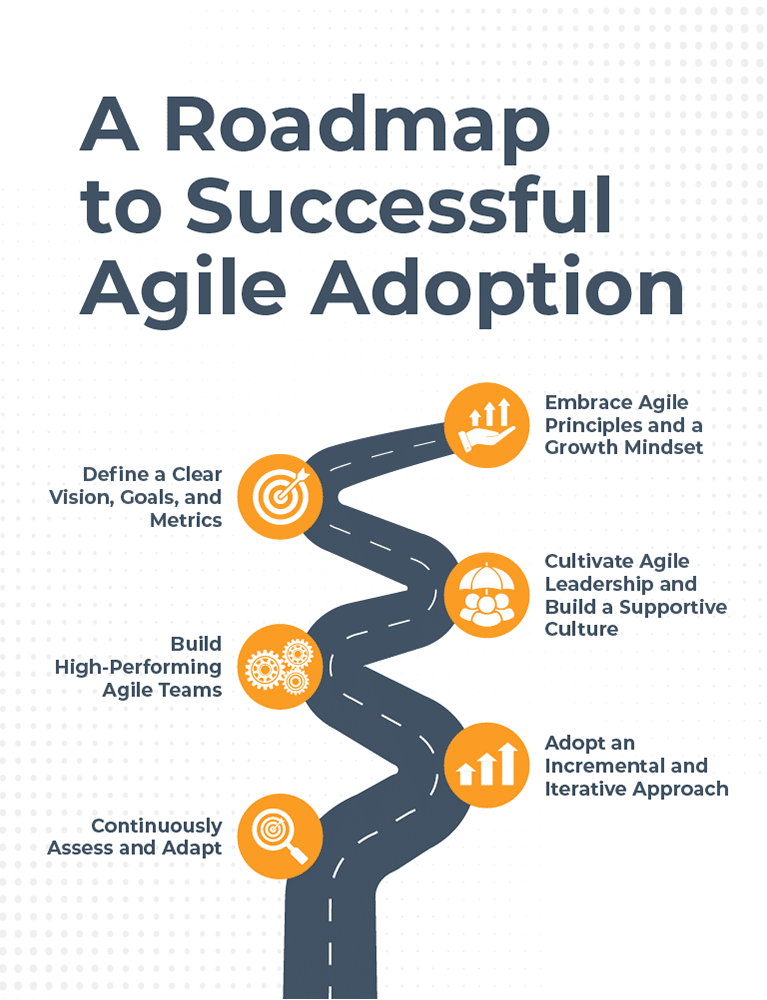Agile adoption is essential for IT leaders who want to drive faster value delivery, boost team collaboration, and remain flexible. By embracing Agile Methodology, organizations can respond quickly to market shifts and deliver quality results.
This guide offers six practical steps to help you adopt Agile quickly and confidently. You’ll learn how to make meaningful changes in your leadership approach, build strong teams, and use powerful tools to track progress and stay on target.
Step 1: Embrace Agile Principles and a Growth Mindset
Successful Agile adoption starts with a solid understanding of agile principles. More than just a set of frameworks, Agile is a way of thinking that prioritizes collaboration, flexibility, and rapid value delivery.
Build an Agile Mindset
Adopting an Agile mindset means:
- Commitment to Learning: Every event—from Sprint Reviews to Sprint Retrospectives—offers a chance to learn and improve. Mistakes become stepping stones for better solutions.
- Delivering Value Fast: Short cycles allow teams to produce tangible results quickly, receive feedback, and adjust priorities.
- Empowerment and Ownership: Cross-functional teams gain the freedom to make decisions and own their work. Leaders support this by removing obstacles.
- Customer Focus: Working closely with stakeholders ensures all efforts are shaped by real customer needs.
Leaders who embrace these proven leadership insights can enhance their effectiveness. Continually revisiting your agile mindset is a reliable way to drive sustained improvement.
Choose the Right Agile Framework
Agile frameworks provide structure to support your new mindset. Consider these popular options:
- Scrum: Uses Sprints, Daily Scrum, Sprint Planning, Sprint Reviews, and Sprint Retrospectives. Key roles include the Scrum Master, Product Owner, and Scrum Team.
- Kanban: Focuses on visualizing work on a Kanban Board and maintaining Work In Progress (WIP) Limits to keep teams moving smoothly.
- Extreme Programming (XP): Emphasizes practices like test-driven development and pair programming for high-quality software development.
By exploring these core leadership fundamentals and selecting a framework that suits your team’s needs, you create a strong foundation for transformation. Developing a strong background in flexible project methodologies can be extended further by adopting effective project planning. This foundational step sets the overall tone and direction for both the culture and operational processes within your organization.
Step 2: Define a Clear Vision, Goals, and Metrics

A clear vision sets the stage for successful Agile adoption. Without a shared purpose, teams can get off track. IT leaders must develop a vision that everyone understands.
Craft a Unified Vision
Your vision should highlight:
- Agile Value: Explain how Agile will boost productivity, quality, and responsiveness.
- Customer Benefits: Describe how Agile adoption will improve customer experiences.
- Organizational Goals: Align Agile with broader objectives such as innovation, team engagement, and interdepartmental collaboration.
For example, your vision might be: “Empower our teams to deliver valuable features faster, foster a culture of innovation, and drive lasting change through open collaboration.”
Translate Vision into Actionable Goals
Break your vision into clear, measurable goals:
- Accelerate Delivery: Reduce release cycles by moving from extended delivery timelines to shorter, iterative cycles.
- Enhance Quality: Set concrete objectives to reduce defects and improve overall product stability.
- Boost Customer Satisfaction: Seek to improve customer feedback scores through quicker turnaround and targeted feature releases.
- Drive Innovation: Encourage regular updates and the rollout of new product prototypes.
Set Meaningful Metrics
Metrics create accountability and help measure progress:
- Tie Metrics to Actions: Determine which performance measures, such as completed stories per Sprint, best reflect your improvement initiatives.
- Use Leading and Lagging Measures: Monitor team velocity as a leading measure while using customer satisfaction as a lagging measure.
- Promote Transparency: Sharing metrics openly with all team members reinforces that each role is essential to achieving success.
Leverage Path to Agility Navigator®
Using Path to Agility Navigator helps IT leaders visualize progress by:
- Tracking team performance in real time.
- Identifying operational gaps where process improvements are needed.
- Guiding actionable next steps to keep your Agile journey on track.
Path to Agility Navigator gives you a clear roadmap to see what needs to change and how to drive measurable improvements. This level of visibility fosters a culture of accountability and continuous learning, making it easier for teams to adapt quickly to internal and external changes.
Step 3: Cultivate Agile Leadership and Build a Supportive Culture
Agile adoption goes beyond processes—it requires leaders who model the new way of working and create a culture that supports change.
Characteristics of Great Agile Leaders
Effective Agile leaders:
- Practice Servant Leadership: They focus on removing roadblocks so teams can perform to their potential.
- Communicate Transparently: Open sharing builds trust and ensures alignment across teams.
- Empower Teams: Leaders grant teams the autonomy to make important decisions and assume ownership of outcomes.
- Embrace Feedback: Actively seeking and incorporating team input is crucial for continuous adaptation.
When leaders demonstrate these traits, they inspire teams to fully embrace Agile practices. The transformation relies on shifting long-held mindsets and behaviors, which makes visible leadership support an indispensable part of a successful Agile transition.
Create a Culture That Embraces Change
To build a culture supportive of Agile, leaders should:
- Invest in Training: Regular Agile training and coaching opportunities boost team confidence and competence.
- Encourage Experimentation: By creating spaces where teams can test ideas without fear of failure, organizations can foster higher levels of innovation.
- Celebrate Success: Recognizing and celebrating both small and big wins reinforces the value of Agile practices.
This cultural shift demands patience and persistence. Creating an environment where the willingness to iterate is encouraged helps to mitigate resistance from team members who are accustomed to traditional, linear processes. It also lays the groundwork for sustained organizational agility over the long term.
Step 4: Build High-Performing Agile Teams
At the heart of Agile Transformation are effective, empowered teams. IT leaders must invest in building teams that work cohesively and respond agilely to change.
Traits of High-Performing Teams
Successful teams typically:
- Bring Diverse Skills Together: A blend of developers, testers, designers, and a dedicated Scrum Master ensures that all technical and creative needs are met.
- Know Their Roles: Clear and defined responsibilities contribute to a focused effort toward achieving a shared Sprint Goal.
- Operate in Unison: Open communication and mutual respect foster a collaborative spirit.
- Commit to Ongoing Learning: Regular training sessions and performance reviews help keep skills current and teams nimble.
Strategies to Foster Team Excellence
Enhance team performance by:
- Providing Continuous Training: Offer relevant certifications, on-the-job learning, and dynamic Agile workshops.
- Encouraging Self-Organization: Allow teams the flexibility to determine the best ways to complete their tasks.
- Optimizing Resource Allocation: Ensure that the right mix of talent is available to address complex challenges without unnecessary delays.
These measures make teams more efficient and ingrain a culture where improvement is viewed as a never-ending journey. High-performing teams are the engine that drives successful Agile Transformations, consistently meeting timelines and delivering quality products.
Step 5: Adopt an Incremental and Iterative Approach
Agile adoption is a journey, not a one-off change. Instead of a full-scale overhaul at once, the emphasis should be on taking small, manageable steps to implement improvements.
Launch Pilot Projects
Begin your Agile journey with focused projects that allow you to test Agile concepts on a small scale. This approach helps you:
- Select Manageable Initiatives: Identify projects with a clear scope and supportive stakeholders.
- Define Clear Success Metrics: Establish tangible benchmarks for improvements in delivery speed, product quality, and customer satisfaction.
- Learn and Iterate: Use lessons learned in pilot projects to optimize processes before broader implementation.
Scale Strategically
After achieving demonstrable success with pilot projects, gradually expand your Agile practices:
- Incorporate Proven Frameworks: Consider frameworks like Scaled Agile Framework® (SAFe®) for larger projects, Large-Scale Scrum (LeSS) to extend Scrum principles across multiple teams, or Disciplined Agile® (DA™) for a more customized approach.
- Build Organizational Buy-In: Address initial resistance by sharing early wins and continuously engaging with all stakeholders through open communication.
- Maintain a Sustainable Pace: Ensure that changes are introduced at a pace allowing teams to absorb new ways of working without becoming overwhelmed.
This incremental, iterative approach reduces risks associated with radical changes and provides ample learning opportunities. By refining your processes using real-world feedback, your organization can steadily progress toward a more agile and responsive operating model.
Step 6: Continuously Assess and Adapt
Agile adoption is an ongoing process. To achieve long-term success, IT leaders must commit to regular reviews of practices, welcome feedback, and make iterative improvements.
Use Feedback to Drive Growth
Constructive feedback is vital for continuous improvement:
- Sprint Retrospectives: Evaluate what worked and what didn’t, then adjust your approach accordingly.
- Daily Syncs: Short, focused sessions keep teams aligned by addressing obstacles and clarifying immediate priorities.
- Customer Input: Leverage real-world feedback from end-users to fine-tune features and product direction.
Evolve Workflows Constantly
It is essential to continuously refine processes:
- Optimize Operational Processes: Adjust Sprint Planning or task prioritization as needed to better align with team capabilities.
- Enhance Team Collaboration: Reduce unnecessary handoffs by keeping core competencies within integrated teams.
- Identify Bottlenecks: Use performance metrics to pinpoint delays and inefficiencies, then address them through Lean Portfolio Management or other improvement methods.
Empower Continuous Improvement with Technology
Path to Agility Navigator plays a crucial role in this journey by enabling you to:
- Monitor team performance in real time.
- Identify areas that require immediate intervention.
- Build a clear, actionable roadmap that guides your continuous improvement efforts.
This adaptive strategy ensures that as your organization grows and market conditions shift, your Agile practices can evolve accordingly. The regular cycle of assessment, feedback, and refinement helps maintain momentum and supports a culture of perpetual learning.
Overcoming Common Challenges in Agile Adoption
Even with a clear roadmap in place, challenges are inevitable. Resistance to change, misaligned expectations, and communication gaps can slow progress. IT leaders should be proactive in identifying potential roadblocks and addressing them through targeted strategies.
For instance, resistance often arises from a lack of understanding or fear of the unknown. By providing robust training, correcting misconceptions, and involving team members in decision-making, you can mitigate these concerns. It is also beneficial to set realistic timelines and celebrate incremental successes. This approach not only reduces anxiety but also fosters a positive environment where change is seen as an opportunity for growth.
Moreover, keeping stakeholders engaged is essential. Regular check-ins and transparent updates facilitate a sense of shared ownership. When team members understand their role in the overall vision, they are more likely to take initiative and contribute to continuous improvement. Overcoming these common challenges not only smooths the path for Agile adoption but also strengthens the overall resilience and adaptability of the organization.
Your Roadmap to Sustainable Agile Success
Agile adoption is not a one-off project—it’s a continuous journey that involves people, processes, and smart use of technology. By following these six essential steps, you set your organization on a path to lasting change. Start by embracing Agile principles and developing a clear vision, then empower your teams through strong leadership and a supportive culture. Scale your Agile practices gradually and use continuous feedback to refine every element of your transformation.
As you move forward, remember that the path to agility is iterative by nature. Consistent learning, ongoing assessment, and strategic adjustments are essential to remain competitive. With tools like Path to Agility Navigator guiding your way, you can visualize progress, address challenges head-on, and drive your organization to new heights of performance and innovation.
Ready to transform your organization? Embrace the journey toward sustainable Agile success and achieve organizational agility with Agile Velocity. Transform your approach to work and pave the way for a future where adaptability, efficiency, and continuous improvement are the foundation of your success.





